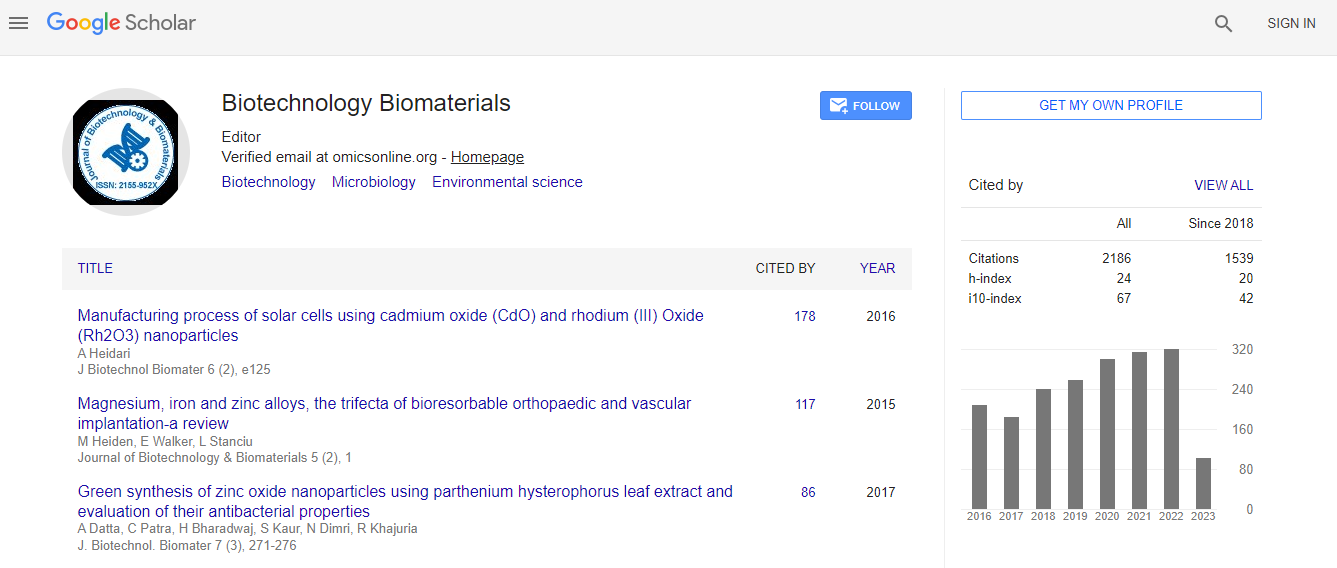Our Group organises 3000+ Global Conferenceseries Events every year across USA, Europe & Asia with support from 1000 more scientific Societies and Publishes 700+ Open Access Journals which contains over 50000 eminent personalities, reputed scientists as editorial board members.
Open Access Journals gaining more Readers and Citations
700 Journals and 15,000,000 Readers Each Journal is getting 25,000+ Readers
Google Scholar citation report
Citations : 3330
Journal of Biotechnology & Biomaterials received 3330 citations as per Google Scholar report
Indexed In
- Index Copernicus
- Google Scholar
- Sherpa Romeo
- Open J Gate
- Genamics JournalSeek
- Academic Keys
- ResearchBible
- China National Knowledge Infrastructure (CNKI)
- Access to Global Online Research in Agriculture (AGORA)
- Electronic Journals Library
- RefSeek
- Hamdard University
- EBSCO A-Z
- OCLC- WorldCat
- SWB online catalog
- Virtual Library of Biology (vifabio)
- Publons
- Geneva Foundation for Medical Education and Research
- Euro Pub
- ICMJE
Useful Links
Recommended Journals
Related Subjects
Share This Page
An improved biofabrication process to enhance cell survival of cartilage regeneration and functionality of the osteoarthritic knee when enriched with bone marrow mesenchymal stem cells
4th International Conference on Advances in Biotechnology and Bioscience
Jose Manuel Baena, J L Carrillo and J A Marchal
REGEMAT 3D, SpainIBIMER-University of Granada, Spain
Posters & Accepted Abstracts: J Biotechnol Biomater
Abstract
Tissue regeneration (TR) is currently one of the most challenging biotechnology unsolved problems. Tissue engineering (TE) is a multidisciplinary science that aims at solving the problems of TR. TE could solve pathologies and improve the quality of life of billions of people around the world suffering from tissue damages. New advances in stem cell (SC) research for the regeneration of tissue injuries have opened a new promising research field. However, research carried out nowadays with two-dimensional (2D) cell cultures do not provide the expected results, as 2D cultures do not mimic the 3D structure of a living tissue. Some of the commonly used polymers for cartilage regeneration are polylactic acid (PLA) and its derivatives such as poly-L-lactic acid (PLLA), poly (glycolic acids) (PGAs) and its derivatives such as poly (lactic-co-glycolic acids) (PLGAs) and polycaprolactone (PCL). All these materials can be printed using fused deposition modeling (FDM), a process in which a heated nozzle melt a thermoplastic filament and deposit it in a surface, drawing the outline and the internal filling of every layer. All this procedures uses melting temperatures that decrease viability and cell survival. Research groups around the world are focusing their efforts in finding low temperature printing thermoplastics or restricted geometries that avoid the contact of the thermoplastic and cells at a higher temperature than the physiologically viable. This has mainly two problems; new biomaterials need a long procedure of clearance before they can be used in clinical used, and restrictions in geometries will limit the clinical application of 3D printing in TE.Biography
E-mail: bd1@regemat3d.com

 Spanish
Spanish  Chinese
Chinese  Russian
Russian  German
German  French
French  Japanese
Japanese  Portuguese
Portuguese  Hindi
Hindi 
